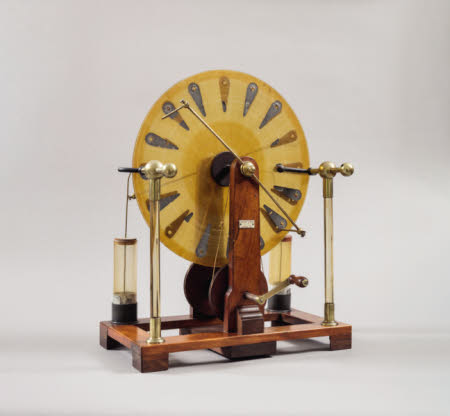Wimshurst machine
Harvey and Peake
Category
Scientific instruments
Date
1883 - 1900
Materials
Glass
Measurements
610 x 267 mm; 483 mm (Length)
Order this imageCollection
Cragside, Northumberland
NT 1231069
Caption
Have you ever touched something and seen a small spark? This electrostatic device – known as a Wimshurst machine – was invented in the 1880s to produce high-voltage static electricity. It works by rotating two glass discs (covered with small metal ‘sectors’) in opposite directions. This causes an imbalance of charges and creates a spark. Accumulated energy can be stored in Leyden jars. These machines became popular in late 19th- and early 20th-century laboratories for electrical experiments, and were also used in early X-ray research. This machine and two Leyden jars can be found in the restored Electrical Room at Cragside, which was used by inventor William, 1st Lord Armstrong (1810–1900) as an experimental laboratory. His book Electric Movement in Air and Water (1897) contained photographs of the stunning patterns (usually invisible) produced by electrical discharges, which he generated with a Wimshurst machine. Armstrong’s pioneering experiments, and the extraordinary images of them recorded by local photographer John Worsnop, have been reimagined for modern visitors to Cragside.
Summary
Wimshurst influence machine for generating static electricity, invented about 1883. In use, the discs rotate in opposite directions and the electricity produced was collected in Leyden jars.
Provenance
Armstrong collection. Transferred by the Treasury to The National Trust in 1977 via the National Land Fund, aided by 3rd Baron Armstrong of Bamburgh and Cragside (1919 - 1987).
Makers and roles
Harvey and Peake, maker
